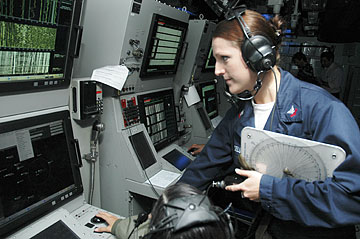
GREGG K. KAKESAKO / GKAKESAKO@STARBULLETIN.COM
Petty Officer Jamie Seluk, a sonar technician on the Pearl Harbor-based cruiser USS Port Royal, tried to identify an underwater contact during yesterday's anti-submarine warfare training in Hawaii waters.
|
|
Submarines in training for underwater warfare
Strike groups practice hunting enemy diesel subs in island waters
60 MILES SOUTH OF OAHU » The prey is no longer deep-water Russian nuclear submarines.
It's the much more quiet but just as deadly diesel subs, numbering about 140, lurking in the Pacific and belonging to countries like China, North Korea and Iran.
EXPEDITIONARY STRIKE GROUP THREE
Commander: Marine Brig. Gen. Carl Jensen
» Amphibious assault ship USS Peleliu (San Diego)
» Amphibious transport ship USS Ogden (San Diego)
» Amphibious dock landing ship USS Germantown (San Diego)
» Destroyer USS Gonzales (San Diego)
» Cruiser USS Port Royal (Pearl Harbor)
» Frigate USS Reuben James (Pearl Harbor)
Sailors: 4,000
Marines: 2,200 from the 11th Marine Expeditionary Unit (California) led by Col. John Bullard
|
Adm. Gary Roughead, commander of the Pacific Fleet, has made it his priority that ships in strike groups undergo at least three days of intensive anti-submarine warfare training before they deploy to the western Pacific.
Much of this training -- this week for the Expeditionary Strike Group Three, from San Diego -- will be conducted in waters around Hawaii. In January, aircraft carrier strike group USS Reagan was the first to undergo the training to track and kill diesel subs.
When Expeditionary Strike Group Three leaves Pearl Harbor on Monday on a six-month deployment, it will be joined by the Hawaii-based cruiser USS Port Royal and frigate USS Reuben James.
Unlike a carrier strike group, which is centered around a vessel like the USS Ronald Reagan and its 75 combat jets, an expeditionary strike group is built around an amphibious assault ship that carries 2,000 Marines.
Capt. Peter Morford, commodore of the Amphibious Squadron Three, said the purpose of anti-submarine warfare "is all about finding the submarine and preventing him from stopping us from doing our mission, which is getting the Marines ashore."
"If air warfare is a high-speed tennis match," Morford said, anti-submarine warfare can be likened to "a chess game that could go on for days."
The three-day exercise in Hawaii waters, which ended today, used two squadrons of P3-Orion sub hunters from Kaneohe Bay and two other Pearl Harbor ships, the USS Hopper and USS Paul Hamilton, and a Canadian frigate to coordinate "the hunt." Although the Navy will not say exactly how many, the role of "enemy subs" was played by Los Angeles-class nuclear subs from Pearl Harbor.
Capt. David Matawitz, who has commanded the 567-foot USS Port Royal since September 2004, said he has undergone more anti-submarine warfare training and exercises this past year, in preparation for his upcoming six-month deployment, than in his combined 22 years in the Navy.
He estimated that his crew had taken part in anti-submarine warfare training every three months.
The hull-mounted sonar at the front of the ship, the towed sonar array and its two helicopters allow the Port Royal to detect and destroy submarines more than 100 miles away, Matawitz added.
Petty Officer Erin Guzman, a sonar technician whose job is to evaluate information sent to Port Royal's sonar room and then fire its torpedoes, said even an exercise "can get really tense."
"We have a lot of information coming from all our sensors," said Guzman, 24, one of Port Royal's 40 female crew members. "A lot of information, and we have to work together."

